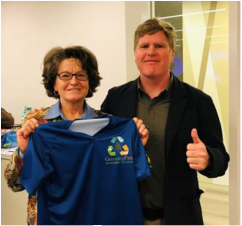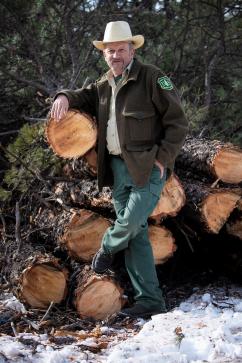Fall 2019/Winter 2020; Volume 4
Update from Greening Fire Team Leadership
On behalf of the National Greening Fire Team, Dennis Fiore, Greening Fire Team Co-Chair, presented Shawna Legarza, USFS Director of Fire and Aviation Management, with a GFT T-Shirt as a thanks for her support. The National Greening Fire Team is working hard to integrate sustainable operations best management practices into the fire community in response to the waste management challenge.
To learn more about the great work that they are doing, see the GFT Summer-Fall Bulletin. Summer-Fall 2019 Bulletin.
Contact Us
Interested in learning more about the Greening Fire Team? Have questions about any of the stories in this bulletin? If so, contact the Greening Fire Team.
Recruiting Interagency Greening Fire Team "Ambassadors"
The National Greening Fire Team serves an interagency mission, but is largely comprised of Forest Service employees. We’re eager to on-board “Ambassadors” from inside (and especially outside) the agency.
What is an “Ambassador?” Glad you asked! “Ambassadors” are not formal Greening Fire Team members, with deliverables and salary funding to cover part of their time. Rather, “Ambassadors” are individuals with a keen interest in advancing sustainable business operations throughout the fire organization. They receive periodic emails, including the Quarterly Highlights Bulletins, and are invited to one or two team update webinars each year.
When possible, they are asked to apply information or products developed by the team, such as the onsite incident recycling Blanket Purchase Agreement.
If you are interested in being a Greening Fire “Ambassador” contact the Greening Fire Team.
Greening Fire Team Website Features
The National Greening Fire Team's public-facing website is a source of information related to sustainable operations best management practices for fire incidents. We strive to keep the website relevant with the most current information. As you navigate the site, notice the hot-links under the Related Content section on the lower left-side of each page.
Meet the Greening Fire Team & Become an Ambassador
Learn about Greening Fire Team Sustainable Operations
Incident Recycling BPA Implementation Quick Guide
Spotlight
Supervisory Forestry-Technician, Tom Dauenhauer, Kaibab National Forest
Do you believe it is important for the USDA Forest Service to take an active role in “greening” fire operations? If so, why?
Yes, I believe we, the Forest Service, should take more of an active role towards greening. For years, it has been disheartening to see all the potentially recyclable material going to some landfill. Now, the materials are going to a recycling center. As crews and such become more accustomed to seeing recycling bins it will become more of a habit for everyone to recycle.
What role do you play at incidents, and how do you think your community could play a more pronounced role in “greening fire” in the future?
I am the logistics chief on a Type 2 team, Southwest Team 4. Our community could do more by “focusing” more on recycling. I think the team does quite a bit of recycling, just needs to be more focused on doing it. By placing a recycling order on our primary supply order, we will have recycling in place from the beginning of the incident. This means team members will be accustomed to recycling and expect it on every incident. As we roll out on new incidents, we will expect to see recycling bins right from the start. If we don’t have that in place we want people to ask why not. Make it a habit!
What recommendations should we focus most on in the future based on the report about greening fire best practices from the Department of Energy National Renewable Energy Laboratory (NREL)?
I think we should focus on solar power and rechargeable batteries. Those two areas would show the “best” bang for your buck, so to speak. We would get more buy-in on solar power at all our camps, especially if used with another battery for storage of energy.
Rechargeable batteries would take some time and energy but would significantly impact our waste output. As a logistics chief, I am opposed to creating a position to deal with recycling because we struggle to bring needed people as is. Creating another position for the team would reduce personnel for another area.
I believe having the recycling contractor work out those issues is a better solution. Somehow working it into the contract about composting makes more sense than creating another position.
Over the years, have you noticed any changes in the USDA Forest Service’s efforts to reduce the environmental footprint of incidents? If so, what changes have been most successful?
I have noticed changes. A significant change has been from saying we were doing something to having contractors on-site implementing real recycling. In the past, we would separate cardboard only to hear that it was going to the same exact spot as the rest of the garbage. Now, our contractors actively ensure that recyclables go where they can be properly recycled. I have always said, “By recycling that bag, bottle, etc. I am not saving the world, just a small piece of it!”
Having observed implementation of the On-site Incident Recycling Blanket Purchase Agreement, what suggestions do you have to improve recycling at incidents?
Over the past two years, I have noticed the most success we have is when we have colored and labeled collection bins spread throughout the incident command post and base camp. These bins must be sturdy enough to withstand winds and yet be compact enough to be placed inside yurts and such.
Having dedicated individuals collecting and sorting the materials makes us all feel part of a more significant project. This is essential because, for our efforts to be successful, we must all feel like a part of the bigger picture. Being part of the bigger project is only successful when the smaller pieces are working, which is happening more and more.
What else should our readers know about you?
I am not a recycling guru or enthusiast. I am just like everyone else - trying to do what is correct to help our planet. If we all use one less thing or recycle one more thing each day, it all adds up to large amounts. In a sense, it is not our individual recycling effort that matters but our collective mindset that changes the good we do. What we do at work carries over to our personal life and vice versa.
Share Your Greening Fire Successes and Lessons Learned from this Fire Year!
Have you led or supported efforts to reduce the environmental impact of incidents this fire year? Do you have a USDA Forest Service computer profile? If so, you are well-positioned to document your experience in the Leadership in Sustainable Operations portal.
All who are striving to live more sustainable are encouraged to enter brief success stories or lessons learned in the Sustainability Stories Portal. Along with highlighting your good work, these stories are used to report to senior leadership and oversight agencies.



